Abstract
Net photosynthetic assimilation rate (A), extractable activities of three photosynthetic enzymes, and the concentrations of six metabolites were determined for wheat (Tricum aestivum L.) leaves as leaf temperature was varied under photorespiring (350 microliters per liter CO2 and 21% O2) and under nonphotorespiring conditions (800 microliters per liter CO2 and 2% O2). The extractable activity of ribulose-1,5-bisphosphate carboxylase (Rubisco) and fructose-1,6-bisphosphatase declined with increasing leaf temperature from 15 to 45°C. Leaf concentrations of ribulose-1,5-bisphosphate (RuBP) declined slightly between 15 and 25°C but increased to a level which is 4 to 5 times the binding site concentration of Rubisco at leaf temperatures of 35 and 45°C. Leaf concentrations of 3-phosphoglycerate, fructose-6-phosphate, and glucose-6-phosphate all declined with increasing leaf temperature. Outside of the limitations imposed by photorespiration, it is proposed that under high light and at suboptimal temperatures, A is limited by rate of utilization of triose phosphate; at optimal temperatures, by the availability of substrate (CO2 and RuBP) under photorespiring conditions or utilization of triose phosphate under nonphotorespiring conditions; and at supraoptimal temperatures, by the activation state of Rubisco.
Full text
PDF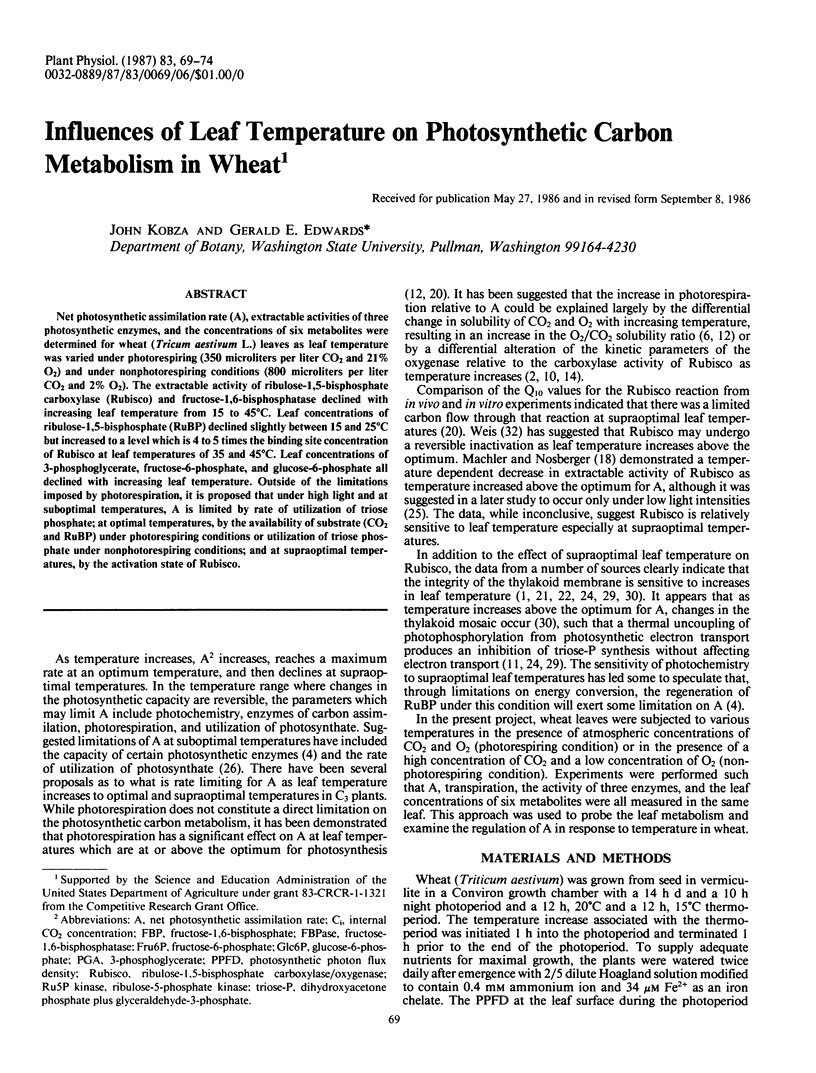
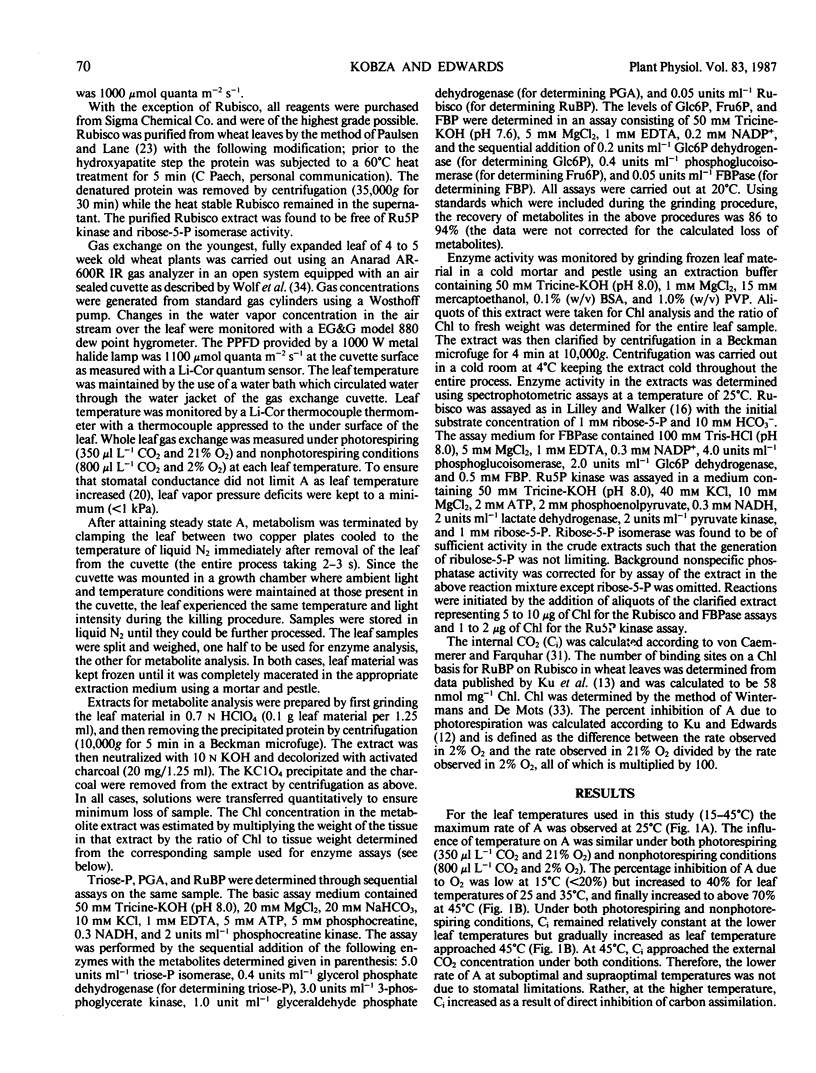
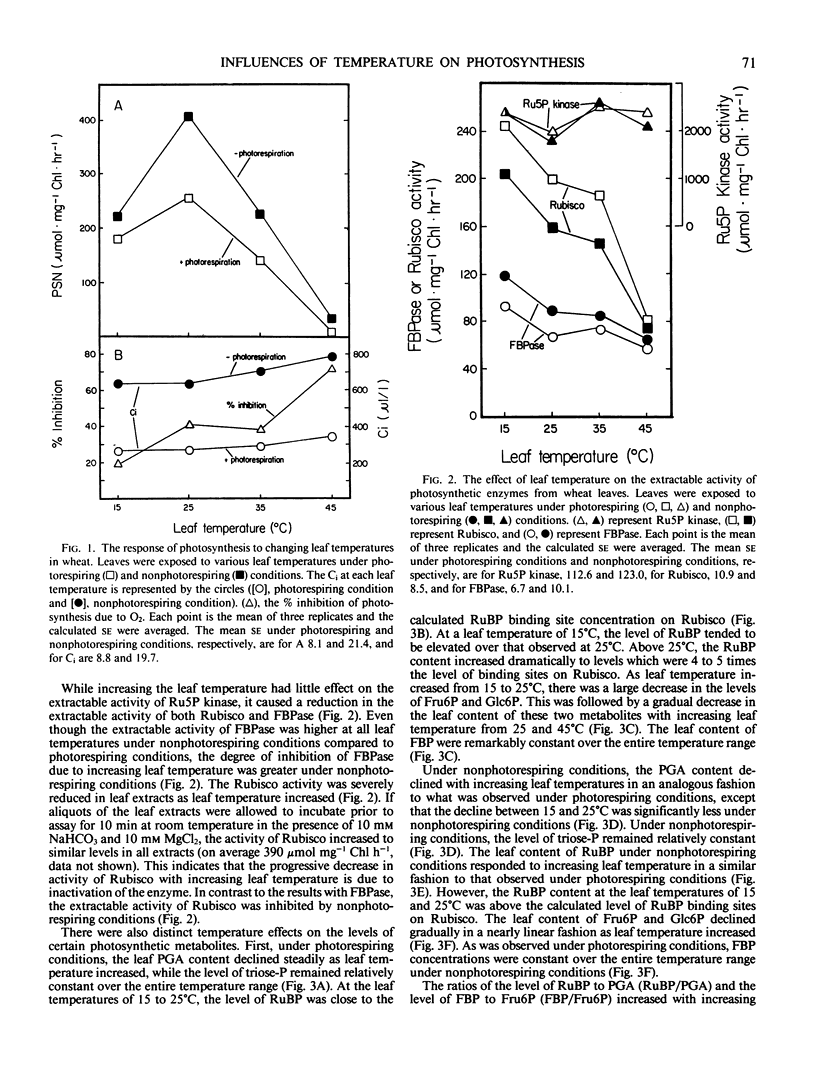
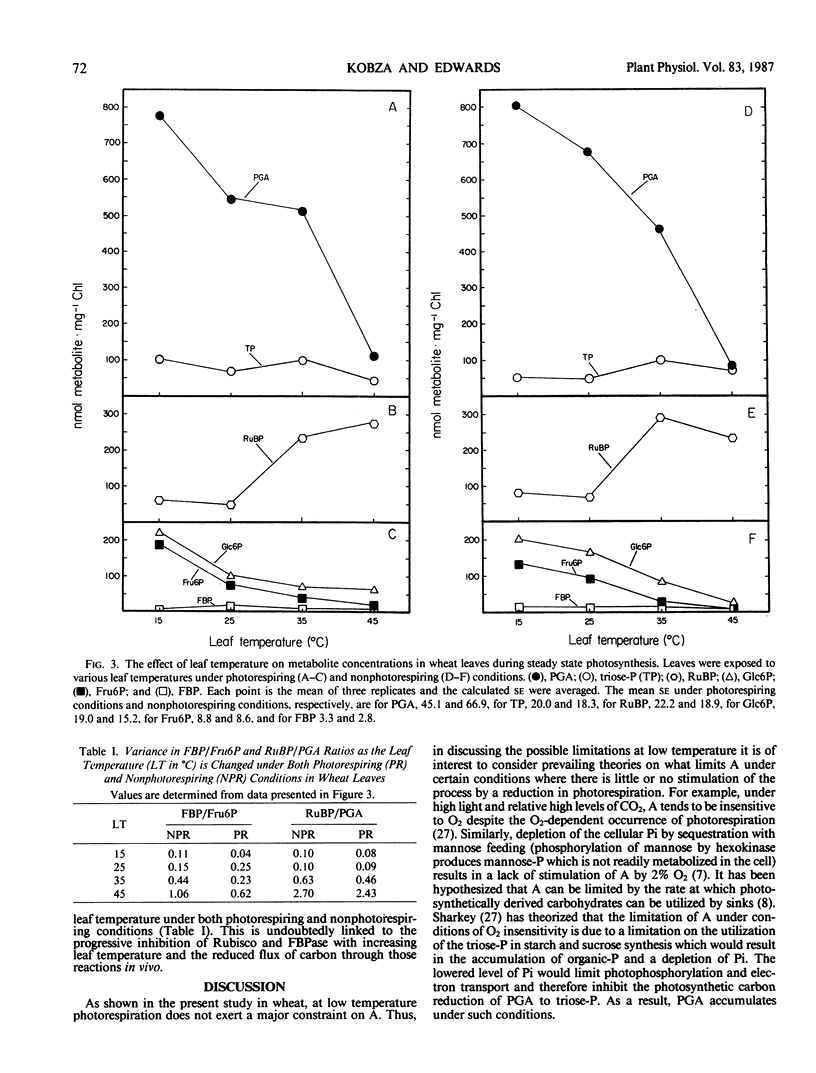

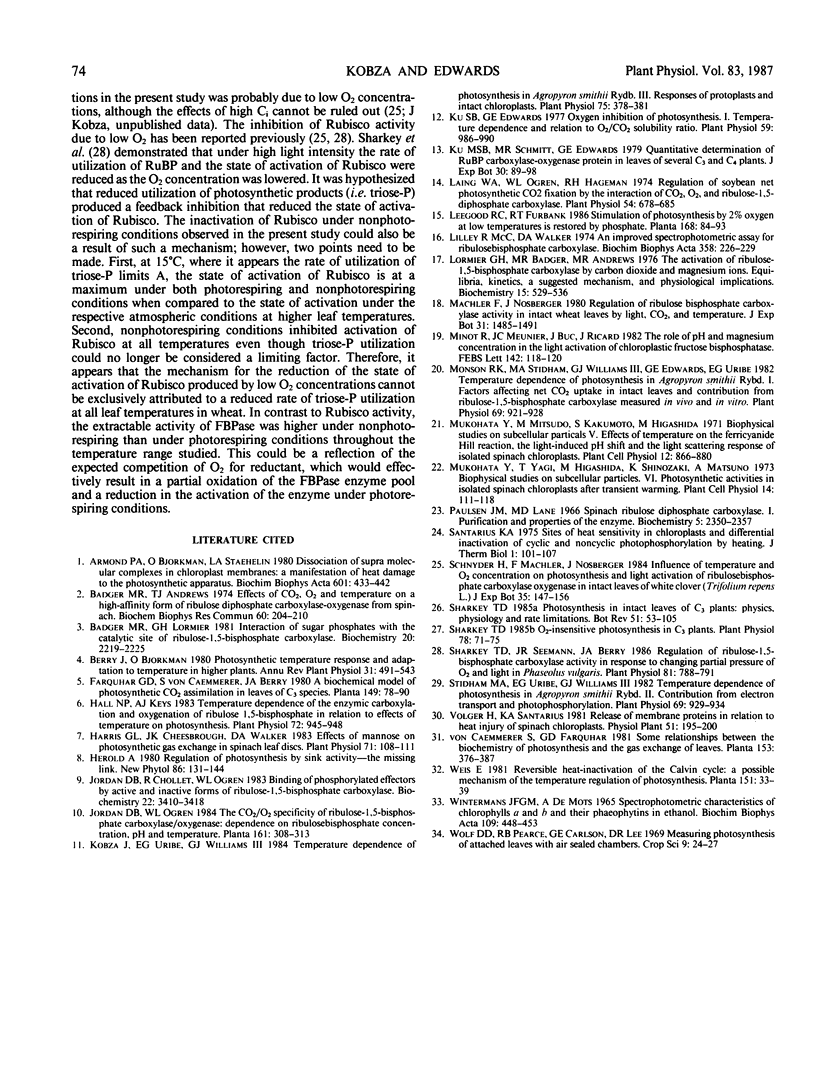
Selected References
These references are in PubMed. This may not be the complete list of references from this article.
- Armond P. A., Björkman O., Staehelin L. A. Dissociation of supramolecular complexes in chloroplast membranes. A manifestation of heat damage to the photosynthetic apparatus. Biochim Biophys Acta. 1980 Oct 2;601(3):433–443. doi: 10.1016/0005-2736(80)90547-7. [DOI] [PubMed] [Google Scholar]
- Badger M. R., Andrews T. J. Effects of CO2, O2 and temperature on a high-affinity form of ribulose diphosphate carboxylase-oxygenase from spinach. Biochem Biophys Res Commun. 1974 Sep 9;60(1):204–210. doi: 10.1016/0006-291x(74)90192-2. [DOI] [PubMed] [Google Scholar]
- Badger M. R., Lorimer G. H. Interaction of sugar phosphates with the catalytic site of ribulose-1,5-bisphosphate carboxylase. Biochemistry. 1981 Apr 14;20(8):2219–2225. doi: 10.1021/bi00511a023. [DOI] [PubMed] [Google Scholar]
- Hall N. P., Keys A. J. Temperature dependence of the enzymic carboxylation and oxygenation of ribulose 1,5-bisphosphate in relation to effects of temperature on photosynthesis. Plant Physiol. 1983 Aug;72(4):945–948. doi: 10.1104/pp.72.4.945. [DOI] [PMC free article] [PubMed] [Google Scholar]
- Harris G. C., Cheesbrough J. K., Walker D. A. Effects of mannose on photosynthetic gas exchange in spinach leaf discs. Plant Physiol. 1983 Jan;71(1):108–111. doi: 10.1104/pp.71.1.108. [DOI] [PMC free article] [PubMed] [Google Scholar]
- Kobza J., Uribe E. G., Williams G. J. Temperature Dependence of Photosynthesis in Agropyron smithii Rydb. : III. Responses of Protoplasts and Intact Chloroplasts. Plant Physiol. 1984 Jun;75(2):378–381. doi: 10.1104/pp.75.2.378. [DOI] [PMC free article] [PubMed] [Google Scholar]
- Ku S. B., Edwards G. E. Oxygen Inhibition of Photosynthesis: I. Temperature Dependence and Relation to O(2)/CO(2) Solubility Ratio. Plant Physiol. 1977 May;59(5):986–990. doi: 10.1104/pp.59.5.986. [DOI] [PMC free article] [PubMed] [Google Scholar]
- Laing W. A. Regulation of Soybean Net Photosynthetic CO(2) Fixation by the Interaction of CO(2), O(2), and Ribulose 1,5-Diphosphate Carboxylase. Plant Physiol. 1974 Nov;54(5):678–685. doi: 10.1104/pp.54.5.678. [DOI] [PMC free article] [PubMed] [Google Scholar]
- Lilley R. M., Walker D. A. An improved spectrophotometric assay for ribulosebisphosphate carboxylase. Biochim Biophys Acta. 1974 Jul 17;358(1):226–229. doi: 10.1016/0005-2744(74)90274-5. [DOI] [PubMed] [Google Scholar]
- Lorimer G. H., Badger M. R., Andrews T. J. The activation of ribulose-1,5-bisphosphate carboxylase by carbon dioxide and magnesium ions. Equilibria, kinetics, a suggested mechanism, and physiological implications. Biochemistry. 1976 Feb 10;15(3):529–536. doi: 10.1021/bi00648a012. [DOI] [PubMed] [Google Scholar]
- Monson R. K., Stidham M. A., Williams G. J., Edwards G. E., Uribe E. G. Temperature Dependence of Photosynthesis in Agropyron smithii Rydb. : I. FACTORS AFFECTING NET CO(2) UPTAKE IN INTACT LEAVES AND CONTRIBUTION FROM RIBULOSE-1,5-BISPHOSPHATE CARBOXYLASE MEASURED IN VIVO AND IN VITRO. Plant Physiol. 1982 Apr;69(4):921–928. doi: 10.1104/pp.69.4.921. [DOI] [PMC free article] [PubMed] [Google Scholar]
- Paulsen J. M., Lane M. D. Spinach ribulose diphosphate carboxylase. I. Purification and properties of the enzyme. Biochemistry. 1966 Jul;5(7):2350–2357. doi: 10.1021/bi00871a025. [DOI] [PubMed] [Google Scholar]
- Sharkey T. D. O(2)-insensitive photosynthesis in c(3) plants : its occurrence and a possible explanation. Plant Physiol. 1985 May;78(1):71–75. doi: 10.1104/pp.78.1.71. [DOI] [PMC free article] [PubMed] [Google Scholar]
- Sharkey T. D., Seemann J. R., Berry J. A. Regulation of Ribulose-1,5-Bisphosphate Carboxylase Activity in Response to Changing Partial Pressure of O(2) and Light in Phaseolus vulgaris. Plant Physiol. 1986 Jul;81(3):788–791. doi: 10.1104/pp.81.3.788. [DOI] [PMC free article] [PubMed] [Google Scholar]
- Stidham M. A., Uribe E. G., Williams G. J. Temperature Dependence of Photosynthesis in Agropyron smithii Rydb. : II. CONTRIBUTION FROM ELECTRON TRANSPORT AND PHOTOPHOSPHORYLATION. Plant Physiol. 1982 Apr;69(4):929–934. doi: 10.1104/pp.69.4.929. [DOI] [PMC free article] [PubMed] [Google Scholar]
- Wintermans J. F., de Mots A. Spectrophotometric characteristics of chlorophylls a and b and their pheophytins in ethanol. Biochim Biophys Acta. 1965 Nov 29;109(2):448–453. doi: 10.1016/0926-6585(65)90170-6. [DOI] [PubMed] [Google Scholar]


